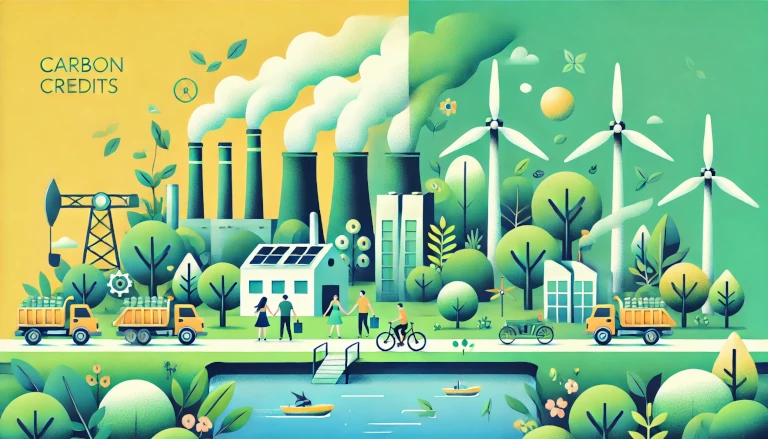As the world faces increasing environmental challenges, carbon credits have emerged as a powerful tool to combat climate change. But what exactly is a carbon credit, and how does it work? In this blog post, we will explain the concept of carbon credits in simple, easy-to-understand language, exploring how they can reduce carbon emissions and help the environment. Whether you’re an individual or a business, understanding carbon credits can empower you to make more sustainable choices.
What is a Carbon Credit?
A carbon credit is a permit or certificate that allows an organization, business, or individual to emit a certain amount of carbon dioxide (CO2) or other greenhouse gases. Typically, one carbon credit equals the right to emit one metric ton of CO2.
The purpose of carbon credits is to incentivize reducing emissions by creating a market where companies or individuals can buy or sell credits based on their carbon emissions.
Example:
Imagine two companies—one uses renewable energy, and the other uses fossil fuels. The first company is reducing its carbon emissions and may not need all the carbon credits allocated to it. Meanwhile, the second company is emitting more CO2 than allowed. The second company can buy extra credits from the first company to cover its additional emissions. This creates an economic incentive for companies to reduce their carbon footprint.
How Do Carbon Credits Work?
Carbon credits operate within a system known as cap-and-trade or carbon trading. Governments or regulatory bodies set a cap on the total amount of greenhouse gases that can be emitted by industries or sectors. Each business is then allocated a certain number of carbon credits that represent their allowable emissions.
If a company emits less than its allotted amount, it can sell its unused credits to other companies that are struggling to meet their emission limits. This creates a financial incentive to reduce emissions.
The system is designed to:
- Encourage businesses to emit less by providing financial rewards for reducing emissions.
- Help balance the total emissions within a particular industry, as companies that emit more than their limit can buy credits from companies that emit less.
Why Are Carbon Credits Important?
The main goal of carbon credits is to reduce global greenhouse gas emissions and help slow climate change. By creating a financial incentive to lower emissions, carbon credits encourage businesses and industries to invest in cleaner, more sustainable technologies.
Example:
A manufacturing company could invest in renewable energy sources, like solar or wind power, to lower its carbon emissions. The fewer emissions the company produces, the more carbon credits it can save or sell to other businesses.
Additionally, some carbon credits are generated from projects that actively remove CO2 from the atmosphere, such as reforestation, renewable energy projects, and methane capture from landfills. Supporting these projects helps in directly reducing the carbon concentration in the air.
Types of Carbon Credits
There are two main types of carbon credits:
- Voluntary Carbon Credits:
These are purchased by individuals or companies who voluntarily want to offset their carbon footprint. For instance, someone might buy carbon credits to offset the emissions from a long-haul flight. - Compliance Carbon Credits:
These are part of government-regulated systems, such as the European Union Emissions Trading System (EU ETS) or California’s Cap-and-Trade Program. Businesses in these regions are required to participate in these programs and must hold enough credits to cover their emissions.
Benefits of Carbon Credits
- Environmental Benefits:
Carbon credits encourage businesses to reduce their carbon footprint, helping to fight climate change and protect the environment. Many credits are tied to projects like renewable energy, reforestation, and conservation, which have a direct impact on reducing greenhouse gases. - Economic Benefits:
By creating a market for carbon credits, businesses that are able to reduce their emissions can sell their excess credits for profit. This provides financial rewards for environmentally responsible companies. - Corporate Social Responsibility:
Companies that purchase carbon credits to offset their emissions show a commitment to sustainability, which can improve their public image and appeal to eco-conscious consumers.
Real-Life Examples of Carbon Credit Use
- Tesla:
Tesla, the electric car manufacturer, earns carbon credits due to its clean energy technology. Tesla sells these carbon credits to other car manufacturers that produce gasoline-powered vehicles, generating significant revenue. - Delta Airlines:
Delta Airlines announced plans to invest in carbon offset projects to counterbalance the emissions produced by their flights. By purchasing carbon credits, Delta is working toward reducing its overall carbon footprint.
The Future of Carbon Credits
As the fight against climate change intensifies, the demand for carbon credits is likely to increase. More governments and industries are adopting cap-and-trade systems to limit emissions, and the voluntary carbon credit market is growing as individuals and companies strive to reduce their carbon footprint.
Investing in carbon credits and offsetting emissions will play an important role in achieving global climate targets, such as the goals outlined in the Paris Agreement. The future will likely see stricter regulations and more innovations that help businesses transition to low-carbon technologies.
Carbon credits are a valuable tool in the global fight against climate change. They create economic incentives for reducing emissions and encourage businesses and individuals to make more sustainable choices. Whether you’re a business looking to lower your carbon footprint or an individual who wants to offset your emissions, carbon credits can make a positive impact on the environment.
Read this in Marathi at कार्बन क्रेडिट म्हणजे काय आणि ते हवामान बदलाशी लढण्यास कसे मदत करते?
Discover more from Green Ecosystem - Renewable Energy, Agriculture, and Environmental Sustainability
Subscribe to get the latest posts sent to your email.
